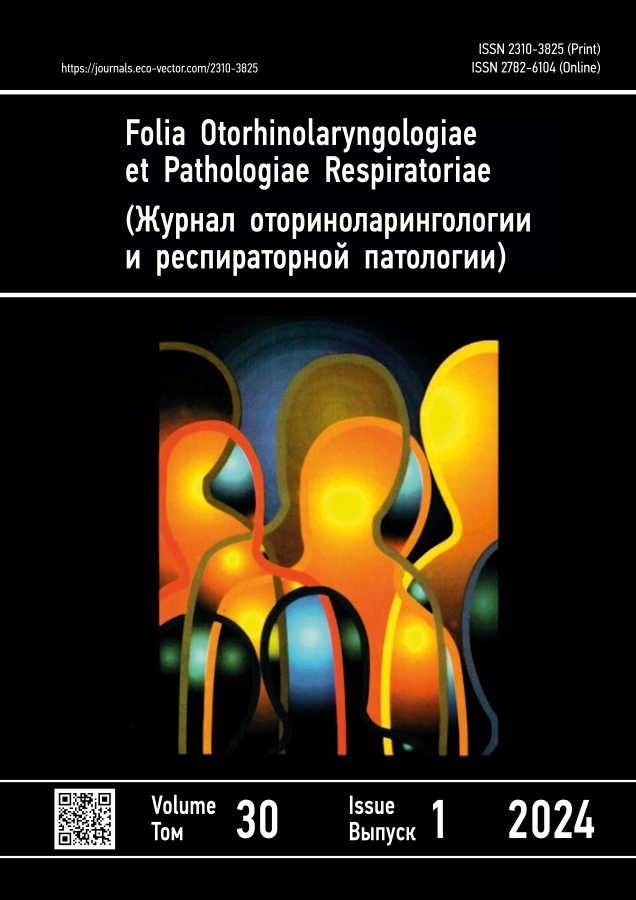The role of anti-reflux therapy in preparing patients for phonosurgical intervention
- Autores: Ryabova M.A.1, Ulupov M.Y.1, Stepanova V.A.1
-
Afiliações:
- Academician I.P. Pavlov First St. Petersburg State Medical University
- Edição: Volume 30, Nº 1 (2024)
- Páginas: 77-85
- Seção: Clinical otorhinolaryngology
- ##submission.dateSubmitted##: 14.02.2024
- URL: https://journals.eco-vector.com/2310-3825/article/view/626942
- DOI: https://doi.org/10.33848/fopr626942
- ID: 626942
Citar
Texto integral
Resumo
BACKGROUND: Among patients who consult ear–nose-throat specialists for dysphonia, 50% were found to have pharyngolaryngeal reflux, often combined with benign neoplasms of the vocal folds, which require phonosurgical intervention. No comparative data in the literature indicate the rationality of the prescription of anti-reflux therapy as part of preoperative preparation.
AIM: This study aimed to evaluate the effect of preoperative antireflux therapy on the functional results of phonosurgical interventions performed using a 445-nm semiconductor laser.
MATERIAL AND METHODS: In total, 59 surgical interventions for dysphonia caused by vocal fold lesions were performed in patients with concomitant objective signs of pharyngolaryngeal reflux. In each case, the intervention was performed using a 445-nm semiconductor laser under direct microlaryngoscopy and general anesthesia with high-frequency ventilation. Group 1 (n = 27) was prescribed a course of anti-reflux therapy 1 month before the planned intervention, and group 2 (n = 32) did not receive this therapy at the preoperative stage. Both groups received the prescribed therapy in the postoperative period. Comparative analysis was carried out according to the results of objective and subjective assessments of the voice function quality (acoustic voice analysis; VHI-10rus questionnaire).
RESULTS: No significant differences in the objective and subjective changes in voice quality were found between the two groups.
CONCLUSIONS: Preventive prescription of anti-reflux therapy before the planned phonosurgical intervention does not guarantee the more successful restoration of vocal function. All patients with signs of pharyngolaryngeal reflux should be prescribed anti-reflux therapy in the postoperative period.
Palavras-chave
Texto integral
Sobre autores
Marina Ryabova
Academician I.P. Pavlov First St. Petersburg State Medical University
Email: marinaryabova@mail.ru
ORCID ID: 0000-0002-6714-9454
MD, Dr. Sci. (Medicine), Professor
Rússia, Saint PetersburgMichail Ulupov
Academician I.P. Pavlov First St. Petersburg State Medical University
Email: mike.ulupov@gmail.com
ORCID ID: 0000-0002-8460-9889
MD, Dr. Sci. (Medicine), Assistant Professor
Rússia, Saint PetersburgValeriya Stepanova
Academician I.P. Pavlov First St. Petersburg State Medical University
Autor responsável pela correspondência
Email: vallery1508@gmail.com
ORCID ID: 0000-0003-4187-5295
Postgraduate student
Rússia, Saint PetersburgBibliografia
- Campagnolo AM, Priston J, Thoen RH, et al. Laryngopharyngeal reflux: Diagnosis, treatment, and latest research. Int Arch Otorhinolaryngol. 2014;18(2):184–191. doi: 10.1055/s-0033-1352504
- Fraser AG. Review article: Gastro-esophageal reflux and laryngeal symptoms. Aliment Pharmacol Ther. 1994;8:265–272. doi: 10.1111/j.1365-2036.1994.tb00287.x
- Wang AM, Wang G, Huang N, et al. Association between laryngopharyngeal reflux disease and autonomic nerve dysfunction. Eur Arch Otorhinolaryngol. 2019;276(8):2283–2287. doi: 10.1007/s00405-019-05482-w
- Lechien JR, Nandhan Sampath Kumar R, Chiesa-Estomba CM. Laryngopharyngeal reflux, and autonomic nerve dysfunction: What about stress? Eur Arch Otorhinolaryngol. 2020;277(10):2937–2938. doi: 10.1007/s00405-019-05567-6
- Vakil N, van Zanten SV, Kahrilas P, et al. The Montreal definition and classification of gastroesophageal reflux disease: a global evidence-based consensus. Am J Gastroenterol. 2006;101:1900–1920; quiz 1943. doi: 10.1111/j.1572-0241.2006.00630.x
- Zelenik K, Kajzrlikova IM, Vitek P, et al. There is no correlation between signs of reflux laryngitis and reflux esophagitis in patients with gastro-esophageal reflux disease symptoms. Acta Otorhinolaryngol Ital. 2017;37:401–405. doi: 10.14639/0392-100X-1237
- Ryabova MA, Vasilevskij DI, Filippov DI, et al. The effect of various forms of pharyngolaryngeal reflux on the larynx. Folia Otorhinolaryngologiae et Pathologiae Respiratoriae. 2020;26(3):70–80. EDN: VYWCTR doi: 10.33848/foliorl23103825-2020-26-3-70-80
- Hayat JO, Gabieta-Somnez S, Yazaki E, et al. Pepsin in saliva for the diagnosis of gastro oesophageal reflux disease. Gut. 2015;64:373–380. doi: 10.1136/gutjnl-2014-307049
- Yılmaz T, Bajin MD, Günaydın RÖ, et al. Laryngopharyngeal reflux, and helicobacter pylori. World J Gastroenterol. 2014;20(27):8964–8970. doi: 10.3748/wjg.v20.i27.8964
- Valitova ER, Chebotareva MV, Berezina OI, Bordin DS. Diagnosis and treatment of gastroesophageal reflux disease: analysis of current recommendations. Effektivnaya farmakoterapiya. 2022;18(22):94–99. EDN: PSIXBB doi: 10.33978/2307-3586-2022-18-22-94-99
- Campagnolo AM, Priston J, Thoen RH, et al. Laryngopharyngeal reflux: Diagnosis, treatment, and latest research. Int Arch Otorhinolaryngol. 2014;18(2):184–191. doi: 10.1055/s-0033-1352504
- Tytgat GN, McColl K, Tack J, et al. New algorithm for the treatment of gastro-oesophageal reflux disease. Aliment Pharmacol Ther. 2008;27:249–256. doi: 10.1111/j.1365-2036.2007.03565.x
- Glicksman JT, Mick PT, Fung K, Carroll TL. Prokinetic agents and laryngopharyngeal reflux disease: a systematic review. Laryngoscope. 2014;124(10):2375–2379. doi: 10.1002/lary.24738
- Lechien JR, Bobin F, Muls V, et al. Changes of laryngeal and extralaryngeal symptoms and findings in laryngopharyngeal reflux patients. Laryngoscope. 2021;131(6):1332–1342. doi: 10.1002/lary.28962
- Karpischenko SA, Ryabova MA, Ulupov MYu. Laser surgery in otolaryngology. Consilium Medicum. 2014;16(11):73–76. EDN: TESNBT
- Karpischenko SA, Ryabova MA, Ulupov MYu, Portnov GV. The choice of parameters for the Lacer application in ENT surgery. Russian bulletin of otorhinolaryngology. 2016;81(4):14–18. EDN: WHZZXR doi: 10.17116/otorino201681414-18
- Chang W, Xu W, Cheng L. Treatment of laryngeal contact granuloma: Surgical therapy or conservative treatment. ORL J Otorhinolaryngol Relat Spec. 2019;81(5–6):348–353. doi: 10.1159/000503975
- Upadhyay A, Singh A, Shrivastava A, Mundra RK. Outcome analysis by voice assessment and videostroboscopy in laryngopharyngeal reflux. Int J Phonosurg Laryngol. 2019;9(2):25–29. doi: 10.5005/jp-journals-10023-1176
- Benninger MS. Phonosurgery for benign lesions of the larynx. Japan J Logopedics Phoniatrics. 2010;51(2):156–161. doi: 10.5112/jjlp.51.156
- Hoffman MR, Simpson CB. Principles of phonosurgery. Int J Head Neck Surg. 2021;12(4):144–152. doi: 10.5005/jp-journals-10001-1513
- Krishtopova MA, Osipuk ES, Semenov SA, Petrova LG. Linguistic adaptation and validation of the voice handicap index (VHI)-30 in patients with dysphonia into Russian. Otorhinolaryngology. Eastern Europe. 2020;10(3):223–234. EDN: ETXOTE doi: 10.34883/PI.2020.10.3.045
- Naufel de Felippe AC, Grillo MH, Grechi TH. Standardization of acoustic measures for normal voice patterns. Braz J Otorhinolaryngol. 2006;72(5):659–664. doi: 10.1016/s1808-8694(15)31023-5
- Teixeira JP, Oliveira C, Lopes C. Vocal acoustic analysis – jitter, shimmer and HNR parameters. Procedia Technology. 2013;9:1112–1122. doi: 10.1016/j.protcy.2013.12.124
Arquivos suplementares













